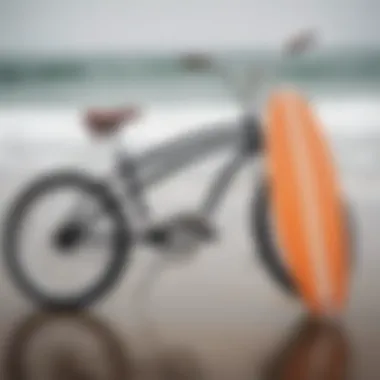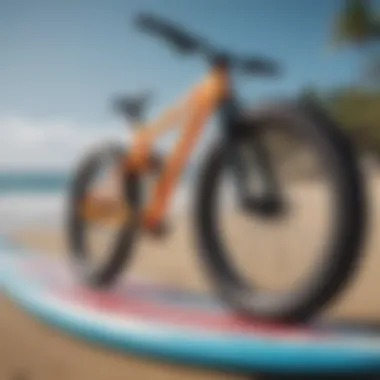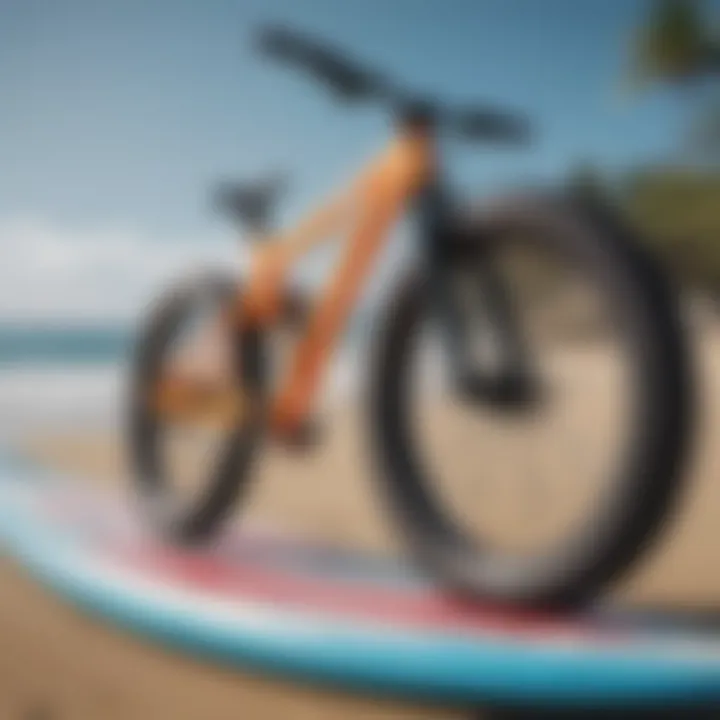Exploring Surfboard Bike Attachments: Design & Benefits


Intro
In the ever-evolving world of surf culture, versatility stands as a vital trait, especially when it comes to equipment. One of the more ingenious inventions that are gaining traction among surf enthusiasts is the surfboard bike attachment. This handy contraption allows surfers to ditch the car and hit the road on two wheels, transporting their boards in a manner that champions both efficiency and a love for the ocean. The fusion of biking and surfing does not merely facilitate travel to the surf spot; it cultivates a lifestyle that resonates with those who cherish the ideals of sustainability and community.
The surge in popularity of these attachments isn't just a fleeting trend; it embodies a shift in how surfers think about their surf time. Riders are keenly aware of their environmental footprint, and bike attachments provide a practical solution. Imagine rolling down the coastline with the wind in your face and a surfboard securely hitched behind you. Not only does this elevate the ride, but it also minimizes reliance on fuel-powered vehicles—a step towards reducing pollution.
This article aims to explore the various types of surfboard bike attachments available, highlighting innovative features that enhance usability while diving into best practices for integrating these mechanisms into a surfing lifestyle. From examining design elements to addressing the perspectives of both manufacturers and surfers, we will chart a comprehensive understanding of how surfboard bike attachments impact surf culture at large.
It's essential to reflect on how this equipment aligns with the principles of eco-conscious living. Choosing accessories that help sustain our beaches and oceans reflects a commitment to preserving these natural habitats for future generations. Dive in with us as we unravel the layers of versatility, practicality, and ecological significance that emerge from the intersection of biking and surfing.
Foreword to Surfboard Bike Attachments
In recent years, surfboard bike attachments have emerged as a revolutionary accessory for surfers, facilitating an easier and more efficient means of transporting surfboards to their favorite breaks. As the surf culture evolves, so does the integration of other outdoor activities, with biking often accompanying the surf experience. This section offers a closer look at the definition, purpose, and underlying significance of surfboard bike attachments, and how they contribute to the thriving lifestyle of both surfers and cyclists alike.
Definition and Purpose
Surfboard bike attachments are essentially devices designed to securely transport surfboards while riding a bicycle. They vary widely in design, from simple racks that clip onto the bike frame to more complex systems that integrate with the overall bike structure. The primary purpose of these attachments is straightforward: to offer surfers a convenient option for getting their boards to the beach without needing a car or cumbersome trolley.
The appeal lies in their versatility and practicality. For someone who frequents the ocean, riding a bike equipped with a surfboard attachment allows for a seamless transition between cycling and surfing. Not just a mode of transport, they embody a lifestyle choice that emphasizes sustainability and connection with nature. Given the rise of eco-conscious living, having options that minimize carbon footprints is undeniably attractive.
Importance in Surf Culture
The significance of surfboard bike attachments transcends mere transportation. They weave into the very fabric of surf culture, reflecting a broader trend toward multi-sport lifestyles and environmental awareness.
- Sustainability: With the globe increasingly focused on sustainability, using a bike instead of a car to haul surfboards aligns perfectly with this ethos. It promotes an appreciation for natural spaces and a reduced reliance on fossil fuels, appealing to environmentally-minded surfers.
- Community and Accessibility: Surfboard bike attachments encourage a sense of community among outdoor enthusiasts. By making it easier for surf fans to access waves, they foster inclusivity. This is essential, especially in urban areas where parking at surf spots can become daunting.
- Adventure and Exploration: Having the freedom to bike anywhere with a surfboard means surfers can discover hidden gems along coastlines that they might not have ventured to by car. This adventurous spirit is central to surfing and enhances the thrill of searching for that perfect wave.
"The surfboard bike attachment is not just a practical tool; it's a bridge connecting two passions that many people hold dear."
In essence, surfboard bike attachments encapsulate the spirit of surfing itself—freedom, creativity, and respect for nature. Through their design and functionality, they play an integral role in how surfers navigate their world, making them indispensable for many within this dynamic culture.
Types of Surfboard Bike Attachments
When it comes to surfboard bike attachments, understanding the different types available is crucial for anyone looking to make an informed choice. With various options on the market, these attachments cater to a range of needs and preferences, whether you are a casual surfer transporting your board to a local beach or a seasoned pro heading into the waves at distant spots. Each type of attachment serves a specific purpose, making it essential to consider their unique features, benefits, and how they align with your surfing lifestyle.
Basic Models
Basic models of surfboard bike attachments are typically the most straightforward option. They usually feature simple mechanisms for securing the surfboard to the bike, incorporating straps and sometimes a bracket. These models are designed for ease of use and accessibility, making them ideal for beginners.
Factors such as weight capacity and compatibility with different bike styles are often highlighted in these products. For instance, a surfboard bike rack from a known manufacturer like Thule can easily fit various bike frames while providing solid grips to ensure stability.
These attachments allow surfers to ride comfortably, even with a board strapped to the side. Such versatility means that you do not have to compromise on your ride when heading to the beach. However, while basic models are convenient, their simplicity sometimes leaves out more advanced features that seasoned surfers might find useful.
Advanced Configurations
On the other end of the spectrum, advanced configurations of surfboard bike attachments offer features that can elevate your surfing experience. These attachments often include specialized brackets, adjustable supports, and even aerodynamic designs that enhance performance during transit. For instance, a configuration that includes flexible mounting points such as the ones from Inno can adapt to various board sizes and shapes.
Durability and secure attachment are crucial here. This means materials used in construction, like reinforced metals and high-density plastics, are prioritized. Additionally, advanced models accommodate more than just surfboards. With these configurations, you can transport stand-up paddleboards or even kitesurfing gear, expanding your options for on-water activities.
The beauty of these attachments lies in their ability to endure the rigors of a bumpy ride or a long-distance journey, ensuring your equipment arrives safely, just like you.
Custom Attachments
Custom attachments represent the pinnacle of versatility when it comes to surfboard bike setups. They allow surfers to meld their specific needs and preferences into a product that works seamlessly with their bike and board combination. Manufacturers often offer customizable features, which might include adjustable heights, additional compartments for gear, or even color options to suit personal styles.
Imagine a scenario where you design an attachment that natively fits your skateboard, ensuring it gets the same attention and care as you rush to the water's edge. Other surf culture enthusiasts have also embraced this idea, often sharing successful custom designs through forums like Reddit, discussing what works and what doesn't.
However, potential users should be aware that while many allow for tailor-made designs, they may come at a higher price point and require more time to source or create.
Incorporating these versatile attachments into your biking experience can turn what was once a tedious journey into a seamless part of your adventure, ultimately enhancing your enjoyment of the surf lifestyle.
To summarize, whether opting for a basic model for everyday use, diving into advanced configurations for enhanced performance, or creating a custom attachment that fits like a glove, there's a broad spectrum of surfboard bike attachments that cater to different surfers' needs. Each choice brings its own set of advantages, promising to enhance how you transport and access your surf gear.
Design Features and Innovations
The realm of surfboard bike attachments thrives on innovation and adaptive design. As these handy tools bridge the gap between cycling and surfing, understanding their design features is crucial. Not only do these elements enhance functionality, but they also improve safety and ease of use. The focus here will delight surfers and outdoor enthusiasts, pulling them into a world where the waves meet the wheels.
Material Considerations


Material choices play a significant role in the performance of surfboard bike attachments. Many models favor lightweight yet durable materials. Aluminum alloys, for instance, are becoming increasingly popular due to their resistance to rust and ease of handling. They offer strength without the added burden. Moreover, composite materials are gaining traction. These elements can withstand rigorous conditions without compromising on the weight.
It’s also worth considering environmental impacts. Manufacturers are slowly leaning towards recycled materials, aligning with sustainability goals in ocean preservation. When surfers select equipment, they often consider how toxins from production could seep into the waters, influencing marine life.
Weight and Portability
In a sport focused on mobility, weight can make or break the experience. Most avid surfers already juggle a surfboard, wetsuit, and other gear; adding a cumbersome attachment is a surefire way to dampen enthusiasm. Many designs underscore simplicity, ensuring that the attachment won’t turn into a dead weight.
Cycling with a surfboard shouldn’t feel like you’re lugging a boat around. Compact designs enable surfers to easily maneuver through city streets or carry the setup to public transportation. Additionally, portability is crucial for spontaneous trips. Surfers appreciate attachments that fold or disassemble quickly, letting them hit the waves without missing a beat.
"A good attachment should feel like an extension of your bike, not an add-on."
Safety Enhancements
Surfing involves crashing waves and swift winds, all while navigating busy streets. Therefore, a robust safety protocol in surfboard bike attachments is paramount. Features like reflective materials and strategically placed lights can enhance visibility. These are particularly useful when traveling at dusk or dawn.
Moreover, secure fastening systems must be highlighted. The last thing anyone wants is for their board to detach amidst the cycling rush. Integrated clamps or locking mechanisms can provide peace of mind, preventing accidents before they occur.
Additionally, some modern attachments include shock absorption systems to minimize swaying. Such innovations mean surfers focus more on their cycling ascent towards the surf rather than constantly adjusting for stability.
In the end, the right combination of materials, portability, and safety features makes for remarkable surfboard bike attachments that elevate the surfing lifestyle. Innovators constantly tweak designs, ensuring that each element contributes seamlessly to the user experience.
User Experiences and Testimonies
Understanding the significance of user experiences and testimonies adds an invaluable layer to any analysis of surfboard bike attachments. These narratives illuminate how individuals from diverse backgrounds interact with the equipment in real-world scenarios. By sharing their firsthand accounts, surfers, bike riders, and industry professionals collectively construct a broader perspective of operational efficacy, design preferences, and the impact of such attachments on their surfing adventures. Ultimately, highlighting these experiences serves to enhance the credibility of the product and reveals insights that data alone cannot cover.
Beginner Perspectives
For first-time users of surfboard bike attachments, the initial experience can be a mixed bag. Many novices find the concept appealing, as it promotes the notion of two passions—surfing and biking—intertwined into one seamless activity. Take, for instance, a beginner surfer named Tom. He recounts how the attachment allowed him to boldly venture out to the beach much more easily:
"I always found it a hassle to carry my board, especially on public transport. Once I attached the surfboard to my bike, it was like a weight lifted off my shoulders! I felt free to ride along the coast."
However, one must remain mindful of potential hurdles. Beginners often face challenges related to balancing and securely fastening the board. Tom also mentioned, "At first, I struggled to align the board properly, leading to some wobbly rides. But I learned the ropes quickly—and now it just feels natural!"
Newcomers to the scene might benefit from user forums or community groups where tricks and tips can be shared. Online platforms like Reddit or Facebook have numerous groups dedicated to cycling and surfing, where seasoned surfers willingly offer guidance. For example, a simple search on Facebook could yield multiple community pages focused on surfboard transport and sharing experiences. They can provide clarity and valuable insights.
Expert Opinions
Experts in both surfing and cycling regard surfboard bike attachments with a mixture of caution and enthusiasm. For instance, seasoned surf instructor, Maria, views these tools as game-changers:
"It opens up the possibility for surfers to explore new areas without the traditional hassle of lugging heavy equipment. It’s not just about having a ride to the beach; it’s the journey that makes it exciting!"
Yet, experts also stress the significance of proper installation and maintenance practices to avoid mishaps on the road. Critically, they note that while the convenience is great, stability is non-negotiable. An unstable attachment can lead to accidents, which could be detrimental not only for the surfer but for others on the road as well.
Expert analysis often includes discussions about brand reliability, stressing how a robust solution can lead to better experiences overall. They frequently recommend researching reputable brands or seeking professional advice on installations. Online marketplaces and expert opinion blogs frequently provide reviews and comparisons, highlighting the pros and cons of specific models. In a world where sharing knowledge is paramount, these insights are golden for both newcomers and seasoned surfers.
As more people engage with surfboard bike attachments, the feedback loop between users and manufacturers will undoubtedly continue to benefit product development, ensuring that equipment evolves in harmony with the needs of the surfing community.
Installation and Maintenance
Effective installation and regular maintenance of surfboard bike attachments are pivotal for maximizing their performance and ensuring a smooth riding experience. Understanding the nuanced aspects of proper setup not only guarantees safety but also fosters an environment where surfers can tackle the waves without the added stress of equipment failure. Furthermore, regular maintenance serves to enhance durability, which is a key factor given the often harsh outdoor conditions these attachments face. The ability to install and maintain one's equipment speaks volumes about the commitment to both the sport and the surrounding environment.
Step-by-Step Installation Guide
Installing a surfboard bike attachment may seem daunting at first, but taken step-by-step, it’s as simple as falling off a log.
- Gather Your Tools: Before you begin the installation, ensure you have the necessary tools on hand. Usually, you'll need a set of wrenches, screwdrivers, and perhaps a level for alignment.
- Read the Instructions: Each manufacturer has its own set of directions for installation. Take a moment to read through them, as they’ll provide vital information specific to your attachment model.
- Attach the Mounting System: Begin by securely attaching the mounting brackets to your bike frame. Make sure that the clamps fit snugly and that there are no loose components. This is crucial, especially if you're navigating rough terrain.
- Position the Bike Rack: Now that the mounting system is in place, add the bike rack itself. It should be aligned directly to the rear of your bike. Make any necessary adjustments to ensure it is level; otherwise, you might face difficulties when attempting to load your surfboard.
- Secure the Surfboard Strap: Attach the surfboard straps to the rack. You should tighten them enough for security but not so much that they could damage the board.
- Final Check: Before taking your bike out, make sure everything is tightly secured. Give the straps a good tug to ensure the board won't wobble or slide during your ride. If it fits like a glove, you’re good to go.
Regular Maintenance Tips
Regular maintenance is essential to ensure that the surfboard bike attachment lasts long and performs optimally. Here are some tips to keep your gear in tip-top shape:
- Check Fasteners Regularly: Every few rides, give a once-over to all screws and bolts. Movement can loosen them up, so it’s wise to check that they remain snug.
- Inspect Straps for Wear: Over time, the straps can fray or degrade due to UV exposure and general use. Replace them immediately if you notice any wear. Safety comes first.
- Clean After Use: After a day at the beach, take a moment to wipe down your attachment. Saltwater and sand can lead to corrosion if left unchecked.
- Seasonal Check-ups: Take a little time at the start of each surf season to go through a full maintenance check. Look for any signs of wear and tear, and test the components to ensure functionality.
Remember, the better the care, the longer your equipment will last, keeping you riding those waves with less hassle.
These installation and maintenance practices not only enhance your surfing experience but also contribute to a responsible and safety-first lifestyle within the surfing community. Following these steps will surely have you riding the waves with confidence and style.


Integration into Surfing Lifestyles
When it comes to surfboard bike attachments, their integration into the lifestyles of surfers isn't just a convenience; it’s an essential aspect for many enthusiasts. As surfers, we often seek ways to merge our love for the ocean with our daily lives. The right bike attachment can help in achieving that harmonious balance, enabling surfers to tackle the roads leading to the surf and experience the thrill of both biking and surfing.
Transportation to Surf Spots
One of the most significant benefits of surfboard bike attachments is the ease of transportation. Instead of wrestling with bulky surfboards or worrying about fitting them onto the car, bike attachments allow seamless mobility. Riders can attach their boards securely, making their commute to the beach more enjoyable. Imagine pedaling along a scenic coastal path with the sea breeze ruffling your hair and your board neatly fixed to your bike. Not only does this transport method ease logistical headaches, but it also enriches the experience of reaching the ocean.
Riding a bike to surf spots fosters a connection with the surroundings. Cyclists often notice the small details like the shimmering ocean waves or the scents of salt and tropical plants along the way. This journey, more so than driving in a car, transforms the day into an adventure from the moment you leave your house.
Benefits of Biking to the Beach:
- Eco-Friendly Option: Reducing your carbon footprint by biking.
- Health Benefits: A great way to increase cardiovascular fitness.
- Easier Parking: Bikes require less space than cars, making it simpler to find a place to park near busy beaches.
Multi-sport Advantages
Additionally, surfboard bike attachments are a boon for those who indulge in multiple sports. For surfers who also enjoy biking, skateboarding, or other outdoor activities, these attachments offer flexibility. Many designs incorporate features that allow surfers to switch between different boards or sports gear quickly. This adaptability caters to a broader range of interests, allowing enthusiasts to optimize their time spent outdoors.
This versatility encourages surfers to explore various terrains and conditions. Whether it's a crisp morning wave or a sunset ride through local trails, having a reliable bike attachment opens doors to spontaneity. It becomes possible to try new spots, engage in impromptu adventures, or even participate in events like surf competitions or community bike rallies.
Incorporating surfboard bike attachments into one’s surfing lifestyle delivers not just practical benefits but also enhances the overall experience of being involved in multiple outdoor pursuits.
“Pairing biking with surfing isn't just about gets from point A to B; it’s about the allure of the journey itself and the joys of embracing varied outdoor activities.”
Environmental Considerations
In today's world, where environmental awareness is paramount, the role of surfboard bike attachments goes beyond mere utility; it encompasses a genuine commitment to sustainable practices. As surfers increasingly seek ways to minimize their impact on the environment, incorporating eco-friendly designs and processes into the design of surfboard bike attachments becomes essential. This section highlights the significance of these considerations and how they relate to the broader surfing culture.
Sustainability in Design
Sustainability in design is more than just a buzzword; it’s about crafting attachments that resonate with our responsibility to the planet. Many manufacturers are now exploring materials that not only provide durability but also boast a lesser environmental footprint.
- Biodegradable Materials: Some brands are embracing biodegradable plastics or composite materials. This shift means that when these attachments reach their end of life, they can break down naturally, leaving less waste behind.
- Recycled Components: Using recycled materials plays a vital role too. By repurposing plastics and metals, manufacturers can help mitigate the impact on raw resource extraction.
- Energy-Efficient Production: Factories utilize cleaner energy sources and implement more efficient manufacturing processes. As a result, the overall energy consumption significantly drops, contributing to lower carbon emissions during production.
Adopting these sustainable practices fosters a sense of alignment with the values of surfers who are conscious of their environmental footprint, making the sport more eco-friendly.
Reducing Carbon Footprint
Reducing carbon footprint is a term many are growing accustomed to, but its implementation can sometimes feel daunting. Thankfully, surfboard bike attachments provide a practical approach that aligns perfectly with this goal. Here’s how:
- Active Transportation: Riding a bike rather than driving to the beach not only reduces emissions but enhances the experience of being in nature. Surfboard bike attachments make this commute seamless, encouraging surfers to opt for their bicycles instead of cars.
- Eco-Friendly Packaging: It’s not just the product itself; manufacturers are also paying attention to packaging. Many companies are now using minimal or recyclable packaging materials to ensure that every aspect of their product respects these environmental commitments.
- Community Engagement: A lot of brands delight in engaging with local communities to promote proper beach clean-ups or awareness campaigns. It’s not just about selling products; it is about fostering a community focused on preservation and sustainability.
"Sustainable practices in surf culture bridge the gap between enjoying the ocean and protecting it. Every small step counts against larger threats."
Through these measures, the silent yet potent philosophy of reducing one’s carbon footprint permeates the surfing community. Embracing surfboard bike attachments isn’t just about convenience; it’s about making choices that echo values of sustainability. As we look toward the future, the marriage of practicality and environmental responsibility promises not only to sustain our beloved surf culture but also to enrich it in ways that harmonize with our planet.
Challenges and Limitations
Compatibility Issues
Understanding the compatibility of surfboard bike attachments is crucial for anyone looking to mesh their biking and surfing lifestyles. Not every attachment can fit all bike models or surfboards. The design, size, and shape of both the surfboard and the bike can create hurdles. For instance, if a surfer owns a wide board and attempts to fit it on a narrow bike rack, they might find themselves in a pickle. Ensuring that the attachment is suitable for both the bike and surfboard dimensions before purchase goes a long way in preventing frustration later on.
Some manufacturers offer universal designs, but these might not always perform well for specific models—meaning surfers could end up with a subpar experience. Moreover, as bike technologies continue progressing, attachments from a few years back might not suit modern bicycles. It's like trying to fit a square peg in a round hole; sure, you could force it, but the result won’t be pretty. Therefore, doing thorough research on compatibility is fundamental.
Key considerations for compatibility include:
- Board Size and Type: Shortboards, longboards, and fish boards vary in size and shape, necessitating different attachment styles.
- Bike Type: Mountain bikes, road bikes, and hybrids might have different standards for attaching equipment.
- Attachment Mechanisms: Pinpointing whether a slide mount, clamp, or hook system is required helps in narrowing down the options.
As the saying goes, “measure twice and cut once.” Taking the time to evaluate these factors can lead to a more seamless transition to the beach.
Legal Regulations
In addition to compatibility issues, legal regulations play an important role in shaping which surfboard bike attachments can be used in public spaces. Many areas have specific rules regarding bike modifications and the hauling of larger items, such as surfboards. Local laws can vary widely; some towns may ban carrying a surfboard on your bike altogether, while others may allow it as long as it meets certain criteria.
It is imperative for surfers to check the regulations in their region. Many city councils have guidelines aimed at ensuring safety on the roads. For instance, if the surfboard covers the back lane of a bicycle or obstructs the rider’s view, that could lead to hefty fines or more severe consequences. Ignoring the legal constraints could sour an otherwise sweet ride to the beach.
Here are a few common types of regulations that one might encounter:


- Load Limits: Certain areas have restrictions on how much weight can be carried.
- Restrictions on Attachment Styles: Some places may dictate how items can be secured to bikes, ensuring they don't impede balance.
- Highway Regulations: Depending on regional traffic laws, different rules will apply to riding on highways or busy streets.
All in all, the combination of compatibility challenges and legal regulations makes it essential for anyone interested in surfboard bike attachments to do their homework. With such considerations, surfers can better prepare for a hassle-free experience confronting the challenges of riding to the surf.
Market Analysis
Analyzing the market for surfboard bike attachments is crucial for understanding its growing significance in the surfing community. This section helps enthusiasts, manufacturers, and even potential investors gauge the current landscape, identify trends, and assess demand. With surfing’s popularity on the rise, the opportunities in this niche market become clearer, offering insights into what works best for the adventurous souls who blend biking with surfing.
Popular Brands and Models
In the vast realm of surfboard bike attachments, certain brands have managed to carve out a niche for themselves, becoming synonymous with quality and innovation. Examples of these brands include Swagman, with its folding kayak and surfboard rack that offers an admirable mix of portability and reliability. Another notable name is Thule, which brings robust engineering to the table, ensuring the safety and stability of your surfboard during transport.
Additionally, Yakima has garnered a loyal following for its user-friendly designs that cater to both casual surfers and serious long-boarders alike. These brands offer models that support a variety of surfboards, ranging from shortboards to longboards, each engineered with distinct features that enhance functionality and ease of use. Whether it’s a simple two-board attachment or a more elaborate setup with adjustable cradles, options abound depending on one’s needs.
- Swagman – Good for portability with solid build.
- Thule – Known for stability and safety features.
- Yakima – User-friendly and versatile designs.
This variety reflects the market’s adaptability to different surfing cultures, marrying well with diverse lifestyle choices in both urban and coastal settings. As such, surfers eager to explore new spots might find these brands setting the standard for quality and convenience in attachment systems.
Price Points and Affordability
When it comes to choosing surfboard bike attachments, price can be a dealbreaker or deal-maker. The range can vary significantly based on the features and brand. Basic models often start from around $50, accommodating those on a budget yet still offering a satisfactory level of quality. On the flip side, high-end models can surpass the $300 mark, often justifiable by their enhanced functionality, durability, and warranties.
Here’s a breakdown that offers a clearer picture:
- Basic Models: $50 - $100
- Mid-range Models: $100 - $200
- High-end Models: $200 and up
- Suitable for casual surfers with light boards.
- Generally more straightforward with installation.
- Better build quality with added features.
- More adaptability for different bike styles.
- Top-notch materials; may include locks and advanced mechanisms.
- Tailored for professionals or serious enthusiasts.
Considering this price spectrum, buyers must weigh their needs against their budget. For instance, investing in a well-engineered attachment can save future costs related to repairs or replacements. Furthermore, local bike shops and online retailers often provide sales that can help enthusiasts score quality gear at a lower price, especially during off-seasons.
"Finding the balance between quality and affordability is the key to making a wise investment in gear that aids your passion for surfing." – Expert feedback from seasoned cyclists
Future Trends and Innovations
In the ever-evolving world of surfboard bike attachments, staying abreast of future trends and innovations is paramount. The intersection of cycling and surfing opens the floodgates to a multitude of advancements that could not only enhance performance but also promote eco-friendliness. As the need for efficient and practical transportation solutions rises, manufacturers are exploring creative ways to cater to the surfing community while addressing environmental concerns. These trends will shape the attachment market, influencing both design choices and user experiences.
Emerging Technologies
As technology advances at breakneck speed, the incorporation of smart features in surfboard bike attachments becomes increasingly viable. Think about GPS tracking systems that prevent theft or sophisticated locking mechanisms designed for user convenience. Picture an attachment that supports real-time weather updates, allowing surfers to plan their trips according to optimal surf conditions.
Furthermore, the potential for lightweight materials like carbon fiber or novel composites enhances portability. These materials are not just about strength but also about reducing the overall weight of attachments, making them easier to manage during those long rides to the beach.
- Smart Innovations: The integration of mobile apps to streamline the user experience.
- Materials Science: New research into aerodynamics and hydrodynamics can derive even better shapes for attachments.
- Sustainable Tech: Use of biodegradable materials in manufacturing processes.
Market Predictions
With consumer preferences shifting rapidly, the surfboard bike attachment market is also prime for transformation. Experts predict a growing demand for customizable attachments that fit individual users' needs. This aspect will not only enhance user satisfaction but also create a more significant market niche for specialized brands.
Also, the price points are expected to adjust as competition heats up. Emerging brands focusing on sustainability could see an uptick in sales as eco-conscious buyers prioritize their purchases accordingly. Furthermore, the rise of e-bikes may lead to a surge in attachments designed explicitly for these electric vehicles, aligning with a broader trend focused on hybrid beach lifestyles.
"Innovation is the key to sustainability in every aspect of life, including the way we surf and cycle."
This dedication to progress not only reflects our current tackling of transportation issues but also influences the surfing culture as a whole.
Finale and Recommendations
The exploration of surfboard bike attachments has shed light on their multifaceted role in both enhancing the surfing experience and promoting a lifestyle that intertwines biking and surfing. The significance of this topic lies not just in its practical applications, but also in the broader perspective of how these attachments contribute to sustainable practices in transportation and leisure activities. As surfing enthusiasts seek new ways to merge their passions, understanding the benefits and nuances of these attachments becomes paramount.
Summary of Key Points
- Versatility: These attachments are designed to fit a variety of bike models, catering to diverse user needs.
- Innovative Designs: Advancements in materials and safety features have dramatically improved usability and reliability, making it easier for surfers to transport their boards.
- Environmental Benefits: Opting for bike transportation reduces carbon footprints and promotes a greener method of reaching surf spots.
- User Insights: Perspectives from both beginners and experts showcase the practical advantages and emotional joy that comes with integrating biking and surfing.
- Future Trends: Emerging technologies promise to further enhance the functionality of surfboard bike attachments, keeping in step with evolving surfing lifestyles.
"Surfboard bike attachments are not just add-ons; they are game-changers for the surfer on the go, making every trip to the waves more efficient and enjoyable."
Final Thoughts for Enthusiasts
As we wrap up this exploration, it’s clear that surfboard bike attachments embody a harmonious blend of surfing culture and a rigorous commitment to sustainability. For surfers, instructors, and lifeguards alike, embracing this integration opens up new avenues for adventure and efficiency. Consider the various options available, weigh their pros and cons, and choose attachments that not only suit your style but also reflect your values concerning the environment. Whether you are a weekend warrior or a seasoned pro, these attachments can augment your lifestyle, allowing you to ride the waves while effectively navigating the road.
In essence, as you gear up for your next surf trip, ponder how a simple bike attachment can elevate your experience and simplify your journey. The ocean is calling, and with the right setup, the ride there can be just as exhilarating as riding the waves.















